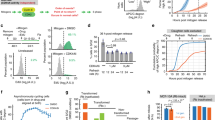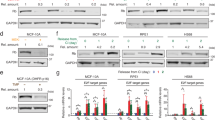Abstract
Studies aimed at examining the precise function(s) of the retinoblastoma tumor suppressor protein, RB, have been hindered by the rapid phosphorylation and inactivation of ectopically expressed RB which occurs in the majority of cell types. Therefore, ectopically expressed RB is a poor inhibitor of cellular proliferation. We have designed constitutively active RB proteins, PSM-RB, that cannot be inactivated by phosphorylation. Using these proteins, we show that unlike wild-type RB, PSM-RB proteins inhibit cell cycle progression in a broad range of tumor cell types. Furthermore, unlike p16ink4a, PSM-RB is also a potent inhibitor of cell cycle progression in RB-deficient tumor cells. Surprisingly, we identified a tumor cell line that is resistant to the cell cycle inhibitory effects of PSM-RB. This finding challenges the hypothesis that RB must be inactivated in all cells for cell cycle progression to occur. Further characterization of this ‘resistant’ tumor line revealed that proliferation of these cells is still inhibited by PSM-RB. We show that this is due to PSM-RB-induced cell death. As such, these studies are the first to show that RB inhibits cellular proliferation through at least two distinct mechanisms – inhibition of cell cycle progression and induction of cell death.
This is a preview of subscription content, access via your institution
Access options
Subscribe to this journal
Receive 50 print issues and online access
$259.00 per year
only $5.18 per issue
Buy this article
- Purchase on Springer Link
- Instant access to full article PDF
Prices may be subject to local taxes which are calculated during checkout



Similar content being viewed by others
References
Antelman D, Perry S, Hollingsworth R, Gregory RJ, Driscoll B, Fung YK and Bookstein R. . 1997 Oncogene 15: 2855–2866.
Bartek J, Bartkova J and Lukas J. . 1997 Exp. Cell Res. 237: 1–6.
DePinho RA. . 1998 Nature 391: 533, 535–536.
Hoshikawa Y, Mori A, Amimoto K, Iwabe K, and Hatekeyama M. . 1998 Proc. Natl. Acad. Sci. USA 95: 8574–8579.
Knudsen ES, Buckmaster C, Chen TT, Feramisco JR and Wang JY. . 1998a Genes Dev. 12: 2278–2292.
Knudsen ES, Pazzagli C, Born T, Bertolaet B, Knudsen KE, Arden KC, Henry R and Feramisco JR. . 1998b Cancer Res. 58: 2042–2049.
Knudsen KE, Arden KC and Cavenee WK. . 1998c J. Biol. Chem. 273: 20213–20222.
Knudsen ES and Wang JY. . 1997 Mol. Cell. Biol. 17: 5771–5783.
Lukas J, Parry D, Aagaard L, Mann DJ, Bartkova J, Strauss M, Peters G and Bartek J. . 1995 Nature 375: 503–506.
Qin XQ, Chittenden T, Livingston DM and Kaelin WG Jr. . 1992 Genes Devel. 6: 953–964.
Sherr CJ. . 1996 Science 274: 1672–1677.
Sidle A, Palaty C, Dirks P, Wiggan O, Kiess M, Gill RM, Wong AK and Hamel PA. . 1996 Critical Reviews in Biochem. Mole. Biol. 31: 237–271.
Templeton DJ, Park SH, Lanier L and Weinberg RA. . 1991 Proc. Natl. Acad. Sci. USA 88: 3033–3037.
Trouche D, Le Chalony C, Muchardt C, Yaniv M and Kouzarides T. . 1997 Proc. Natl. Acad. Sci. USA 94: 11268–11273.
Wang JY. . 1998 Trends Cell Biology 8: 116–120.
Wang JY, Knudsen ES and Welch PJ. . 1994 Cancer Res. 64: 25–85.
Weinberg RA. . 1995 Cell 81: 323–330.
Welch PJ and Wang JY. . 1993 Cell 75: 779–790.
Whitaker LL, Su H, Baskaran R, Knudsen ES and Wang JY. . 1998 Mole. Cell. Biol. 18: 4032–4042
Zacksenhaus E, Bremner R, Jiang Z, Gill RM, Muncaster M, Sopta M, Phillips RA and Gallie BL. . 1993 Cancer Res. 61: 115–141.
Zhu L, van den Heuvel S, Helin K, Fattaey A, Ewen M, Livingston D, Dyson N and Harlow E. . 1993 Genes Devel. 7: 1111–1125.
Acknowledgements
The authors thank Dr JYJ Wang (UCSD, Biology and Cancer Center) for inspired discussion and initial support of this project. Drs G Wahl and T Kendo (Salk Institute) for the generous gift of the plasmid encoding H2B-GFP. We also thank C Buckmaster for logistical support. KE Knudsen is supported by a postdoctoral fellowship from the National Cancer Institute (CA82034). E Weber was supported by the Swiss National Foundation. This work was also supported by a grant to JR Feramisco from the California Tobacco Related Disease Research Program and a grant to ES Knudsen from American Cancer Society (ACS-IRG189). ES Knudsen is a Kimmel Scholar.
Author information
Authors and Affiliations
Rights and permissions
About this article
Cite this article
Knudsen, K., Weber, E., Arden, K. et al. The retinoblastoma tumor suppressor inhibits cellular proliferation through two distinct mechanisms: inhibition of cell cycle progression and induction of cell death. Oncogene 18, 5239–5245 (1999). https://doi.org/10.1038/sj.onc.1202910
Received:
Revised:
Accepted:
Published:
Issue Date:
DOI: https://doi.org/10.1038/sj.onc.1202910
Keywords
This article is cited by
-
A Population Pharmacokinetic and Pharmacodynamic Analysis of Abemaciclib in a Phase I Clinical Trial in Cancer Patients
Clinical Pharmacokinetics (2018)
-
Putting the pieces together: How is the mitochondrial pathway of apoptosis regulated in cancer and chemotherapy?
Cancer & Metabolism (2014)
-
Kaposi’s sarcoma-associated herpesvirus lana2 protein interacts with the pocket proteins and inhibits their sumoylation
Oncogene (2014)
-
Identification and characterization of retinoblastoma gene mutations disturbing apoptosis in human breast cancers
Molecular Cancer (2010)
-
Evidence for a mitochondrial localization of the retinoblastoma protein
BMC Cell Biology (2009)



